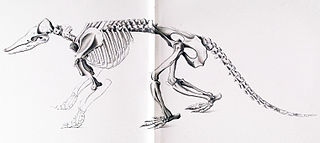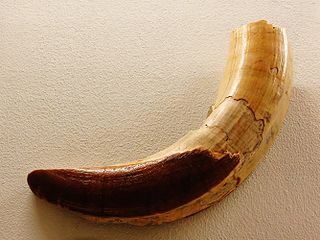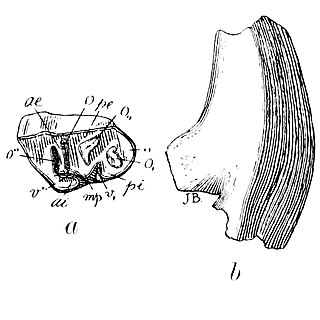
Cramauchenia is an extinct genus of litoptern South American ungulate. Cramauchenia was named by Florentino Ameghino. The name has no literal translation. Instead, it is an anagram of the name of a related genus Macrauchenia. This genus was initially discovered in the Sarmiento Formation in the Chubut Province, in Argentina, and later it was found in the Chichinales Formation in the Río Negro Province and the Cerro Bandera Formation in Neuquén, also in Argentina, in sediments assigned to the SALMA Colhuehuapian, as well as the Agua de la Piedra Formation in Mendoza, in sediments dated to the Deseadan. In 1981 Soria made C. insolita a junior synonym of C. normalis. A specimen of C. normalis was described in 2010 from Cabeza Blanca in the Sarmiento Formation, in sediments assigned to the Deseadan SALMA.
Henricosborniidae is a family of extinct notoungulate mammals known from the Late Paleocene to Middle Eocene of Argentina, Bolivia and Brazil. The name honors U.S. paleontologist Henry Fairfield Osborn.

Proplatyarthrus is an extinct genus of ground sloths of the family Megalonychidae, endemic to Chubut Province, Argentina in South America.

Stegotherium is an extinct genus of long-nosed armadillo, belonging to the Dasypodidae family alongside the nine-banded armadillo. It is currently the only genus recognized as a member of the tribe Stegotheriini. It lived during the Early Miocene of Patagonia and was found in Colhuehuapian rocks from the Sarmiento Formation, Santacrucian rocks from the Santa Cruz Formation, and potentially also in Colloncuran rocks from the Middle Miocene Collón Curá Formation. Its strange, almost toothless and elongated skull indicates a specialization for myrmecophagy, the eating of ants, unique among the order Cingulata, which includes pampatheres, glyptodonts and all the extant species of armadillos.

Parastrapotherium is an extinct genus of South American land mammal that existed from the Late Oligocene to the Early Miocene. The genus includes some of the largest and smallest known astrapotherian, but at present no generally recognized description can adequately characterize it.

Proschismotherium is an extinct genus of ground sloth of the family Megalonychidae, endemic to Argentina during the Early Miocene. It lived from 17.5 mya — 16.3 mya, existing for approximately 1.2 million years. The type, and only, species, P. oppositum, was named in 1902 by Florentino Ameghino based on a single specimen found in the Santacrucian-aged Colpodon Beds of Argentina. Ameghino in 1902 placed Proschismotherium in the Megatheriidae, alongside Hapaloides, which was its sister taxon.
Astrapothericulus is an extinct genus of mammals, belonging to the order Astrapotheria. It lived during the Lower Miocene in what is now South America.
Prolicaphrium is an extinct genus of proterotheriid litoptern that lived during the Early Miocene, in what is now Argentina. Fossils have been found in the Sarmiento Formation of Argentina.
Proadinotherium is an extinct genus of toxodontid. It lived between the Late Oligocene and the Early Miocene in what is now South America.

Argyrohippus is an extinct genus of notoungulate, belonging to the family Notohippidae. It lived from the Late Oligocene to the Early Miocene, and its fossilized remains were found in South America.

Trachytherus is an extinct genus of mesotheriid notoungulate that lived from the Late Oligocene to the Early Miocene in what is now South America.

Isotemnus is an extinct genus of notoungulate belonging to the family Isotemnidae. It lived from the Late Paleocene to the Middle Eocene of what is now Argentina.
Pleurostylodon is an extinct genus of notoungulate belonging to the family Isotemnidae. It lived during the Middle Eocene, in what is now Argentina.
Colpodon is an extinct genus of herbivorous mammal, belonging to the order Notoungulata. It lived during the Early Miocene, in what is today Argentina and Chile, in South America.

Cochilius is an extinct genus of interatheriid notoungulate that lived between the Late Oligocene and the lower Miocene in what is now Argentina.

Proeutatus is an extinct genus of xenarthran, belonging to the order Cingulata. It lived during the Early Miocene, and its fossilized remains were discovered in South America.

Prozaedyus is an extinct genus of chlamyphorid armadillo that lived during the Middle Oligocene and Middle Miocene in what is now South America.
Glyptatelus is an extinct genus of glyptodont. It lived from the Late Eocene to the Middle Oligocene in what is now Argentina and Bolivia.

Ortotherium is a genus of megalonychid ground sloth from the Late Miocene Ituzaingó Formation of Entre Rios Province, Argentina. Although many species were described, the only valid species of the genus is Ortotherium laticurvatum, with many species being junior synonyms. Ortotherium is known from very fragmentary material, all of which is material from the mandible and teeth. The holotype of O. laticurvatum consists of an incomplete left dentary that had been unearthed from a series of sediments known as ‘Conglomerado osifero’ in Paraná, Argentina. Argentina paleontologist Florentino Ameghino named the species in 1885, though he would go on to name four more, invalid, species of the genus. One species however, O. brevirostrum, has been reclassified as Mesopotamocnus.
Liarthrus is a genus of astrapotherid mammal known from the Late Oligocene Sarmiento Formation of Santa Cruz Province, Argentina. It was described by the Argentine paleontologist Florentino Ameghino in 1895 along with several other genera from the "Pyrotherium Beds", which were then believed to date to the Cretaceous period. Ameghino described Liarthus on the basis of fragmentary, being only a right astragalus, premolar 4, and an incomplete premolar from the upper jaws. Only one species was described, L. copei, the species name honoring the American paleontologist Edward Drinker Cope, who lived during the same interval as Ameghino. Liarthrus was synonymized with the other astrapothere Parastrapotherium in 1914 by American mammologist Frederic Loomis, though it was revalidated by a 2008 analysis of Parastrapotherium. Liarthrus was a herbivorous mammal, being an astrapothere, which had large tusks on their skulls and mandibles in addition to a large body size.













